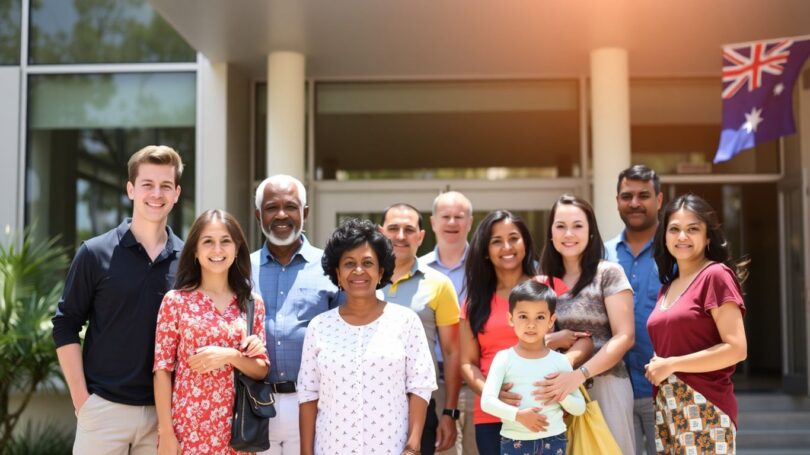If you’re wondering who qualifies for DHHS grant program in Australia, you’re not alone. There’s a lot of talk about these grants, especially since they help fund so many health and community projects. But figuring out if you or your group can actually apply isn’t always clear. Basically, it depends on what the grant is for and the type of organisation you represent. Here’s a straightforward look at what you need to know for 2025.
Key Takeaways
- Most DHHS grants are aimed at organisations like charities, government bodies, schools, and healthcare providers, not usually individuals.
- Individuals can sometimes benefit from DHHS funding through local services or special research awards, but direct grants are rare.
- Your project or program has to clearly link to DHHS goals like improving health or helping vulnerable groups.
- Organisations need to show they’re legitimate (like being registered charities or official government bodies) and able to manage money properly.
- Always check the specific rules for each grant before applying, as requirements can change depending on the funding round.
Understanding DHHS Grant Program Eligibility in Australia

So, you’re tossing up whether to apply for a DHHS grant this year? You’re not the only one. The Department of Health and Human Services (DHHS) in Australia runs a stack of grant programs, but figuring out if you or your organisation actually qualify can get a bit confusing. Here’s a solid breakdown to help clear things up.
Main Purposes and Scope of DHHS Grants
The DHHS hands out grants to support projects that make Australians healthier and strengthen community wellbeing. It’s not just about big research projects—it could be local health initiatives, community support for vulnerable groups, or programs to boost public health services. Typical focus areas include:
- Improving access to healthcare
- Supporting mental health and wellbeing
- Funding medical and public health research
- Backing services for at-risk groups such as families, children, or older people
Most DHHS grants are intended for organisations that aim to deliver real, on-the-ground benefits in health, research, or community support—not for personal use by individuals.
Types of Organisations Commonly Funded
When it comes to getting funding, not every group gets a look-in. Here are the main groups who often receive DHHS grants:
| Organisation Type | Common Examples |
|---|---|
| Non-Profit Organisations | Charities, local service groups |
| Government Bodies | Councils, state agencies |
| Educational Institutions | Schools, universities |
| Healthcare Providers | Public hospitals, community clinics |
In most cases, grants go to groups that are registered legal entities able to show a record of working in health or community support. If this sounds like you, registering with GrantConnect and Community Grants Hub is where you’d usually start.
Role of Government, Non-Profit and Research Bodies
DHHS grants usually flow to a few key players:
- Non-profits and charities that deliver community programs or support vulnerable people.
- Government agencies—either state, local, or Indigenous councils—working on health or social projects.
- Educational and research bodies, mainly for public health or medical studies.
The thing is, most grants aren’t up for grabs for businesses looking to turn a profit, or individuals hoping for direct cash in hand. Instead, the focus is on established organisations that can run effective programs and show they’re responsible with public money.
Not every project is a fit, and not every organisation is eligible, but understanding where you stand is the best place to start before you get serious about applying. If you’re in one of these categories and your project actually lines up with DHHS priorities, it’s worth a closer look at the program details.
Eligible Applicant Types for DHHS Grants
Jumping into DHHS grant applications can feel like sorting laundry when you’ve just moved houses—there are way more piles than you expected. So, who actually qualifies to throw their hat in the ring? Let’s look at the main types of groups getting a steady shot at DHHS funding.
Non-Profit Organisations and Charities
Non-profits and charities are front and centre when it comes to DHHS grants. If your group runs community health clinics, operates food banks, or supports mental health services, you’re already in familiar territory.
- Primary focus on public health, welfare, or community research.
- Can include large national charities or small local groups.
- Often required to show proof of charitable status and a direct link to the grant’s health-related goals.
A quick table to show where not-for-profits generally hit the mark:
| Area of Focus | Typical Eligible Non-Profits |
|---|---|
| Community Health Services | Local health centres, clinics |
| Family & Youth Support | Shelters, care programs |
| Research & Awareness | Health foundations, advocacy |
While not every non-profit will be a fit for every DHHS grant, those with a hands-on record in community health and wellbeing stand the strongest chance.
State and Local Government Bodies
State and local governments are another reliable home for DHHS grants. They’re often conduits for big funding streams that trickle down into the community via local agencies, hospital networks, or outreach projects.
- Includes state government departments, council health teams, and regional boards.
- Typically need to prove their formality as government entities.
- Grants may focus on issues like substance abuse, disability support, or public health system upgrades.
Some examples of programs commonly run by these bodies:
- Immunisation or vaccination drives
- Emergency healthcare preparedness
- Expanding addiction support services
Educational and Healthcare Institutions
Universities, TAFEs, and healthcare providers also feature regularly on DHHS grant recipient lists—especially when the work connects to public health or research. Schools might even get a look-in if they’re stacking up qualifications for allied health professionals or running local health education projects (postgraduate scholarships help set the scene).
- Universities and research institutes can land project and research grants.
- Hospitals and clinics seek funding for community outreach and innovation.
- Application needs to show a real link between the project and public benefit.
| Institution Type | Example Projects |
|---|---|
| University/TAFE | Health research, workforce training |
| Hospital/Clinic | Outreach, pilot programs, access drives |
| School | Child health and wellbeing education |
If you’re part of an educational or healthcare setting, be ready to back up your application with solid community engagement and a clear plan for making an impact.
The odds aren’t the same for everyone, and a lot depends on your track record, capacity, and fit with program guidelines. Start with these categories, but always double check individual grant criteria before spending hours on paperwork.
Individual Access to DHHS Grant Funding
While most DHHS grants in Australia are aimed at organisations, there are limited opportunities for direct funding to individuals. Understanding where individuals fit in can prevent wasted time and effort during the application process.
Direct Grants for Individuals: Rare Exceptions
It’s unusual for DHHS to provide grants directly to individuals. Most funding flows through organisations, but here are the rare cases where individuals might be eligible:
- Scholarships for further study or professional development
- Fellowship programs for advanced health or medical research
- Special awards for innovation or outstanding community health contributions
The table below compares the frequency of different types of DHHS funding for individuals:
| Funding Type | Common? |
|---|---|
| Research Fellowships | Sometimes |
| Individual Project Grants | Rare |
| Professional Development Scholarships | Occasionally |
| General Community Grants | Not available |
If you’re not connected with a sponsoring organisation or institution, direct DHHS funding is very unlikely. Most people will need to work through local councils, community groups or universities.
Fellowships and Research Training Awards
For individuals working in health or research, fellowships and targeted training programs are the main route for direct funding. These programs usually have strict criteria:
- You must have relevant qualifications or track record
- Research must align with DHHS or health priorities
- Applicants often need institutional support or a host organisation
For more about specific opportunities like health research fellowships, check the Supporting Regional and Remote Volunteers Grants 2025 for up-to-date eligibility details and timelines.
Receiving Benefits Through Funded Local Programs
Even though individuals can’t usually apply directly, you can still benefit from DHHS grants:
- Community programs deliver services funded by DHHS grants (think mental health workshops, aged care activities, support for chronic conditions)
- Healthcare providers, local councils, and non-profits often create outreach opportunities using these funds
- Some grants aim to boost voluntary participation and training through local initiatives
If you’re looking to participate, contact your local council, health service provider, or community group to see what programs are running in your area.
DHHS Grant Alignment and Project Suitability

If you’re preparing an application for a DHHS grant in Australia, it’s not just about meeting the basic eligibility. You need to show that what you’re proposing actually fits with what DHHS wants to fund. This is where a bit of extra thought pays off—you want them to picture your project making a real difference, right in line with their aims.
Demonstrating Alignment with DHHS Mission
- Make it clear how your project answers DHHS’s core purpose—improving community health and wellbeing.
- Map your goals to the department’s priorities: think preventative health, equitable access, or support for at-risk groups.
- Point out relevant government initiatives (like closing health gaps for First Nations peoples—see government strategies to reduce disparities), and make that connection obvious in your proposal.
Targeting Community Health and Wellbeing Outcomes
- Your application needs to focus on practical outcomes that lift community health.
- Give concrete examples; what are you actually doing differently? Will you run more clinics, offer new training, or reach a hard-to-access group?
- Outcome measures are important. These could be:
- Fewer hospital admissions
- More local residents taking up health checks
- Higher rates of childhood immunisations
Example Table: Simple Outcomes Table
| Objective | Outcome Indicator |
|---|---|
| Increase health checks | % rise in annual health checks |
| Expand access in rural areas | # of sites opened |
| Improve support for older adults | Satisfaction scores surveyed |
Supporting Vulnerable or Underserved Groups
- DHHS puts a priority on projects serving people who usually miss out. These could be:
- Aboriginal and Torres Strait Islanders
- Low-income families
- Rural or remote residents
- People with disabilities
- Children, youth, and older adults
- Explain, in plain language, how your work will reach these groups. Spell it out simply—if you’ll bring health services to an outlying town or create programs specifically for marginalised communities, say so.
When you build your project idea around the real needs of your community, and clearly match your aims with what DHHS cares about, your proposal stands out for all the right reasons.
Key Organisational Eligibility Requirements
To even make it onto the shortlist for a DHHS grant in 2025, organisations need to prove they’re set up properly and can be trusted to manage public money. These checks are in place to make sure the funds really make a difference in people’s lives.
Proof of Legal Entity Status and Compliance
If you’re trying for funding, don’t even think about skipping the paperwork.
- Your organisation must supply evidence you’re legally registered in Australia—often your ABN and, if you’re a charity, proof of Deductible Gift Recipient (DGR) status.
- Local or state government bodies need their official designation.
- All applicants must be able to show their constitution or rules, sometimes even your certificate of incorporation.
| Documentation Needed | Example |
|---|---|
| ABN certificate | Australian Business Number |
| DGR endorsement (if a charity) | From Australian Tax Office |
| Incorporation certificate | From state/territory authority |
| Official council/government ID | Local or state government departments |
Without these basic proofs, grant applications usually don’t even get looked at.
Capacity to Manage Funds Responsibly
DHHS wants to see that you can actually handle the grant.
- Solid financial records: Audited statements, budgets, and evidence you’ve managed money before.
- Systems in place: Good accounting software, clear reporting processes, and proper checks on spending.
- Skilled staff: Experience with past projects and the right people for project delivery and financial management.
- Recent project reports: Evidence you’ve delivered on promises (e.g. acquittal reports).
Your ability to manage grants is a huge part of being a responsible applicant. DHHS needs to trust that funded programs will run smoothly and with proper accountability, especially in communities that rely on social support or health outcomes.
Evidence of Past Project Delivery and Financial Recordkeeping
You’ve got to show you’re not new to this. That means:
- Case studies or examples of similar grants or programs you’ve handled before.
- Proper records of money spent, people served, and goals met.
- Positive references or testimonials from funders where possible.
If you’re a group that works with people who have unique needs—maybe you support first-time homeownership or run community health programs like those under the Shared Equity Scheme NSW—demonstrate how your history matches the work DHHS wants to fund.
All up, getting over these eligibility hurdles isn’t just about ticking boxes. It’s about showing the DHHS you’re reliable, stable and ready to make a proper impact with the resources they provide.
Program-Specific Eligibility Criteria to Consider
Understanding DHHS grant eligibility isn’t just about whether you fit broad categories like "non-profit" or "educational body" – you really need to get into the details of each grant program. Every round can have its own quirks, so it’s not one-size-fits-all. Here’s what to keep in mind.
Geographic Focus and Priority Areas
Some DHHS grants are only open to groups or services in certain locations.
- Grants may target very specific areas, such as rural regions, low-income suburbs, or places facing health workforce shortages.
- Sometimes the focus is as narrow as one or two postcodes or even a suburb.
- Priority might change every year, depending on wider health trends or emerging issues in Australia.
Here’s a quick look at how this can play out:
| Grant Example | Area Focused | Eligibility Condition |
|---|---|---|
| Community Health Access Fund | Rural QLD & VIC | Must operate in designated rural zones |
| Urban Family Support Initiative | Western Sydney | Need to serve local family cohorts |
| Remote Health Workforce Scheme | NT & WA remote towns | Staff based in listed LGAs |
Don’t assume your region qualifies – always double-check area lists in the program documents before starting your application.
Target Population Requirements
Usually, DHHS grants want to support specific groups rather than the "general community". Here’s what this means:
- Your project might have to serve children, seniors, people with disabilities, or culturally diverse groups.
- For some grants, you must prove participants meet income or health criteria.
- The application might request current stats on those you’re aiming to help.
If you’re new to this, think of it like getting first home buyer grants – they’re not open to just anyone, you have to match strict eligibility criteria tied to your situation and location.
Project or Service Type Limitations
Even if your organisation and your audience fit the bill, not every project will qualify. Look out for:
- Service Type – Some grants are only for healthcare delivery, while others fund infrastructure, training, or mental health programs.
- Timeframe – There may be restrictions on how long your project can run (e.g. 12 months max).
- Duplication – If a similar service is already funded in your area, you might bump into a roadblock.
- Projects need to tick all boxes for size, scope, and focus.
- You’ll usually be asked to justify how your activity fits the DHHS priorities and what unique benefit it brings.
Careful reading of the fine print saves a heap of wasted time on applications that just won’t get up. Go through the instructions, don’t rush, and if in doubt, ask the grant’s contact officer before putting pen to paper.
Strengthening Your DHHS Grant Application
Getting past eligibility for a DHHS grant is only half the trouble. Actually winning funding is tough—loads of groups apply and the bar is high. Standing out comes down to preparation, clear messaging, and showing real community backing. Here are some practical tips to give your application a real shot.
Demonstrating a Clear Mission and Evidence Base
You probably know what problem you want to solve, but the reviewers need specifics. Spell out exactly what your organisation is tackling and how this links to DHHS priorities. Talk about the gaps in your community, describe your target group, and tie your project goals back to the kinds of outcomes that DHHS cares about—like improved health access or better mental health support.
Don’t just claim your approach will work—prove it. Use current stats, outcome measures from similar programs, or even stories showing how things changed last time you ran a related project. Rural healthcare organisations are having more success recently by showing evidence—like data trends and evaluation findings—in their DHHS proposals. Check out how they use real success stories to persuade funders.
Checklist for a Strong Case:
- Show how the project matches DHHS goals.
- Provide clear, recent stats about community need or impact.
- Include evaluation results from previous work if possible.
Having a clear line from your mission statement to your evidence of need helps funders see you’re not just passionate—you’re prepared and capable, with proof to back it up.
Building Strategic Partnerships for Impact
Grouping up can boost your chances. Collaborate with other organisations, councils, health services, or research bodies in your area. Partnerships don’t just look good—they mean you can tackle broader issues, share costs, and reach more people.
Some ways to show strong partnerships:
- Signed letters from collaborating organisations.
- Joint evaluation plans or shared resources.
- Community leader endorsements.
Review panels like seeing a whole community effort instead of just one group going it alone.
Providing Robust Data and Community Support
Numbers matter, but back them with real voices. Blend stats with letters from local leaders, testimonials from previous participants, or feedback from your intended population. Reviewers want to see evidence the community is behind your project, that people actually want what you’re pitching, and you can measure success at the end.
Here are some types of support to include:
- Community survey results or waiting lists for your services
- Past project data (attendance, uptake, satisfaction rates)
- Quotes from councils, Indigenous organisations, or peak bodies
| Evidence Type | How It Helps Your Application |
|---|---|
| Local health data | Proof of genuine, current need |
| Letters from partners | Validates collaboration and reach |
| Participant testimonials | Shows impact and real-world success |
| Output and outcome numbers | Demonstrates track record and results |
In the end, it’s about showing that your project fits what DHHS wants to fund, that it stands up to scrutiny, and the community is genuinely on board. Strong evidence and good partnerships can go a long way towards landing that all-important grant.
Conclusion
So, that’s the gist of who can actually get a DHHS grant in Australia for 2025. It’s not as simple as ticking a box and hoping for the best. Most of the time, it’s organisations—like charities, schools, hospitals, and government bodies—that get a shot at this funding, not individuals. If you’re an individual, you’ll probably benefit from programs run by these groups rather than getting the money yourself. The main thing is making sure your project lines up with what DHHS wants to achieve—better health and stronger communities. If you reckon you fit the bill, check the details for the specific grant, get your paperwork sorted, and don’t be afraid to ask questions if you’re stuck. It can be a bit of a process, but with a clear plan and a bit of patience, you might just get across the line.
Frequently Asked Questions
Can individuals apply directly for DHHS grants in Australia?
Most DHHS grants are not open to individuals. The majority go to organisations like charities, government bodies, schools, or hospitals. Individuals usually benefit by using services or programs funded by these grants, not by getting the money themselves.
What types of organisations are usually eligible for DHHS grants?
DHHS grants are mostly given to non-profit groups, charities, state and local governments, universities, and healthcare providers. Sometimes, research bodies and community organisations can also apply if their work fits the grant’s goals.
Do I need to prove my organisation is official to apply?
Yes, you must show your organisation is properly registered, like having an Australian Business Number (ABN) or being listed as a charity. If you can’t prove your legal status, your application won’t be accepted.
What kinds of projects does DHHS want to fund?
DHHS looks for projects that improve health, support the community, or help people who need it most. Your project should clearly match what DHHS is trying to achieve, like better health services, research, or help for vulnerable groups.
Are there special rules for different grants?
Yes, every grant has its own set of rules. Some are only for projects in certain places, like rural areas, or for specific groups, like children or older people. Always read the details for each grant to make sure you qualify.
How can I make my DHHS grant application stronger?
Show that your project matches DHHS’s goals, give proof that your idea works, and explain how you’ll manage the money. Working with other groups or showing community support can also help your application stand out.








